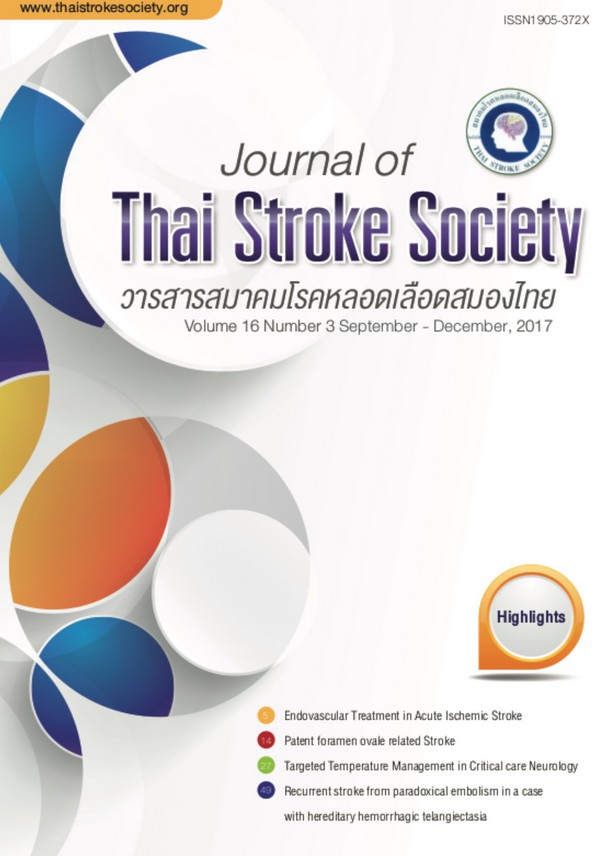Endovascular Treatment in Acute Ischemic Stroke
Keywords:
acute stroke, mechanical thrombectomy, endovascular treatmentAbstract
Stroke is the major leading cause of death worldwide and the global burden attributable to stroke is increasing. The current evidence about good outcome in acute stroke management suggested aspirin giving in 48 hours or anticoagulant in cardioembolic stroke, intravenous rt-PA giving within 4.5 hours, caring stroke patient in stroke unit, decompressive wide craniectomy in middle cerebral artery infarction, and the last new evidence of mechanical thrombectomy or endovascular treatment. Endovascular thrombectomy is of benefit to most acute ischemic stroke patient caused by occlusion of the large vessels. We must to know how to select acute stroke patient for endovascular thrombectomy.
References
American Heart Association/American Stroke Association. Stroke 2015; 46:3020-35.
Goldstein LB, Bushnell CD, Adams RJ, et al. Guidelines for the primary prevention of stroke: a guideline for healthcare professionals from the American Heart Association/American Stroke Association. Stroke 2011; 42(2):517-84.
Ciccone A, Valvassori L, Nichelatti M, et al. Endovascular treatment for acute ischemic stroke. N Engl J Med 2013; 368:904-13.
Berkhemer OA, Fransen PS, Beumer D, et al. A randomized trial of intraarterial treatment for acute ischemic stroke. N Engl J Med 2015; 372:11-20.
Goyal M, Demchuk AM, Menon BK, et al: Randomized assessment of rapid endovascular treatment of ischemic stroke. N Engl J Med 2015; 372:1019-30.
Campbell BC, Mitchell PJ, Kleinig TJ, et al. Endovascular therapy for ischemic stroke with perfusion-imaging selection. N Engl J Med 2015; 372:1009–18.
Saver JL, Goyal M, Bonafe A, et al. Stentretriever thrombectomy after intravenous t-PA vs. t-PA alone in stroke. N Engl J Med 2015; 372:2285-95.
Jovin TG, Bonafe A, Cobo E, et al. Thrombectomy within 8 hours after symptom onset in ischemic stroke. N Engl J Med 2015; 372:2296-306
Nambiar V, Sohn SI, Almekhlafi MA, et al. CTA collateral status and response to recanalization in patients with acute ischemic stroke. AJNR Am J Neuroradiol
2014; 35:884-9.
DeSousa KG, Potts MB, Raz E, et al. Turning point of acute stroke therapy: mechanical thrombectomy as a standard of care. World Neurosurg 2015; 83:953-6.
Almekhlafi MA, Davalos A, Bonafe A, et al. Impact of age and baseline NIHSS scores on clinical outcomes in the mechanical thrombectomy using solitaire FR in
acute ischemic stroke study. AJNR Am J Neuroradiol 2014; 35:1337-40.
Downloads
Published
How to Cite
Issue
Section
License
ข้อความภายในบทความที่ตีพิมพ์ในวารสารสมาคมโรคหลอดเลือดสมองไทยเล่มนี้ ตลอดจนความรับผิดชอบด้านเนื้อหาและการตรวจร่างบทความเป็นของผู้นิพนธ์ ไม่เกี่ยวข้องกับกองบรรณาธิการแต่อย่างใด การนำเนื้อหา ข้อความหรือข้อคิดเห็นของบทความไปเผยแพร่ ต้องได้รับอนุญาตจากกองบรรณาธิการอย่างเป็นลายลักษณ์อักษร ผลงานที่ได้รับการตีพิมพ์ในวารสารเล่มนี้ถือเป็นลิขสิทธิ์ของวารสาร





